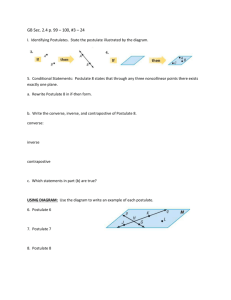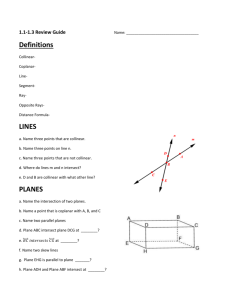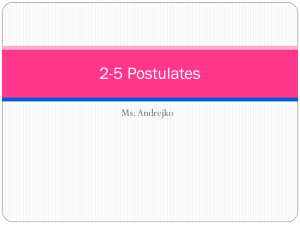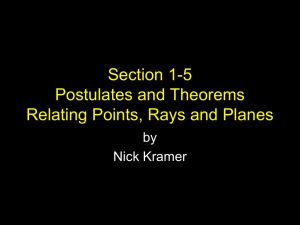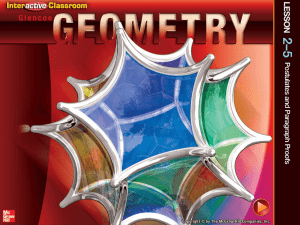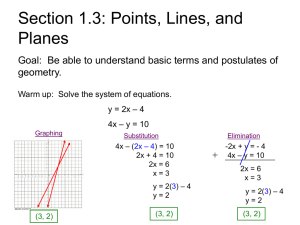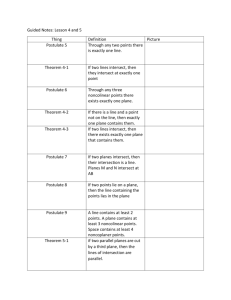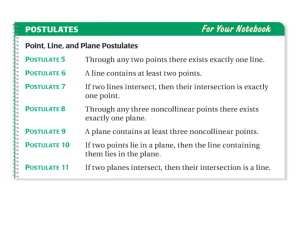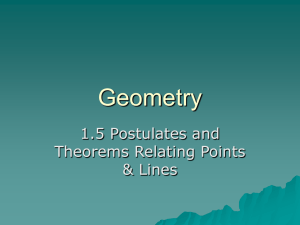Chapter 2 Lesson 5 Guided Notes Date___________ Postulate __
advertisement
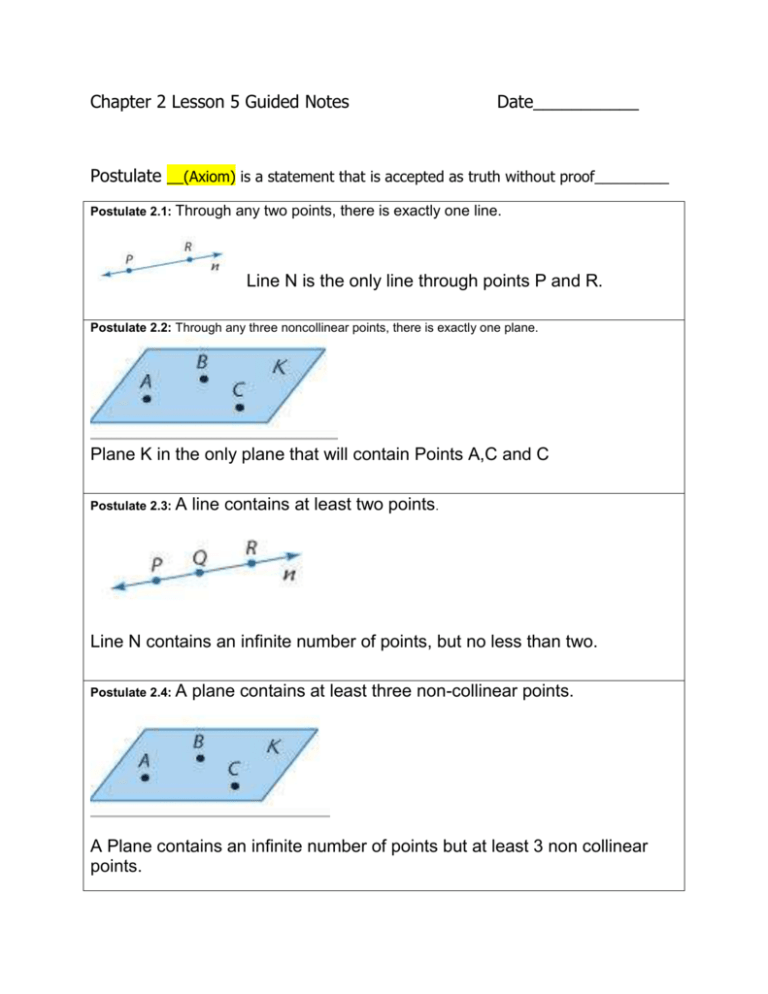
Chapter 2 Lesson 5 Guided Notes Date___________ Postulate __(Axiom) is a statement that is accepted as truth without proof_________ Postulate 2.1: Through any two points, there is exactly one line. Line N is the only line through points P and R. Postulate 2.2: Through any three noncollinear points, there is exactly one plane. Plane K in the only plane that will contain Points A,C and C Postulate 2.3: A line contains at least two points. Line N contains an infinite number of points, but no less than two. Postulate 2.4: A plane contains at least three non-collinear points. A Plane contains an infinite number of points but at least 3 non collinear points. Postulate 2.5: If two points lie in a plane, then the entire line containing those points lies in the plane. IF A and B lie on a plane then Line AB also lies on the plane Postulate 2.6: If two lines intersect, then their intersection is exactly one point. Lines s and t intersect at Point P Postulate 2.7: If two planes intersect, then their intersection is a line. Line w is the intersection of Planes F and G Example: Determine whether each statement is always, sometimes, or never true. a. There is exactly one plane that contains points A, B, and C. ___sometimes, because if the points are collinear then there will be multiple planes that will go through that line – see picture in postulate 2.7 b. Points E and F are contained in exactly one line. ___always – this is postulate 2.1_ c. Two lines intersect in two distinct points M and N. ___never – see postulate 2.6 Exercises Determine whether each statement is always, sometimes, or never true. 1. A line contains exactly one point. Never – see postulate 2.3 A line contains exactly 2 points 2. Noncollinear points R, S, and T are contained in exactly one plane. Always – see postulate 2.4 3. Any two lines ℓ and m intersect. Sometimes, they could be parallel lines which would never intersect. 4. If points G and H are contained in plane ℳ, then ̅̅̅̅ 𝐺𝐻 is perpendicular to plane ℳ. Never – GH is in plane M. See postulate 2.5 5. Planes ℛ and 𝒮 intersect in point T. Never – the intersection of two planes is always a line. See 2.7 6. If points A, B, and C are noncollinear, then segments ̅̅̅̅ 𝐴𝐵 , ̅̅̅̅ 𝐵𝐶 , and ̅̅̅̅ 𝐶𝐴 are contained in exactly one plane. Always – see Postulate 2.2 ̅̅̅̅ and 𝑫𝑬 ̅̅̅̅ || 𝑫𝑬 ̅̅̅̅ are in plane Q and 𝑨𝑪 ̅̅̅̅ . In the figure, 𝑨𝑪 State the postulate that can be used to show each statement is true. 7. Exactly one plane contains points F, B, and E. Always Postulate 2.2 8. ⃡𝐵𝐸 lies in plane Q. Always Postulate 2.5 Matching: 1. Through any two points, there is exactly one line. ___E or A___ 2. Through any three noncollinear points, there is exactly one plane. ___D_____ 3. A line contains at least two points. ___A or E____ 4. A plane contains at least three noncollinear points. ___D____ 5. If two points lie in a plane, then the entire line containing those points lies in the plane. __C_ 6. If two lines intersect, then their intersection is exactly one point. __F__ 7. If two planes intersect, then their intersection is a line. _B__ One of these Pictures can be used Twice E. A. B. C. D F. Theorem ___Once a statement has been proven then it is called a theorem. This is a statement that can be proven. We use Postulates to prove them._________________ Deductive Argument ___logical chain of statements (arguments) linking the given to what you are trying to prove._______________________________________________ Deductive Arguments are “airtight” and inductive arguments are “probable.” Once a Conjecture has been proven it can be used in other proofs. Such as the midpoint theorem: If C is the Midpoint of AB then AC = BC. Inductive: Given a pattern 1 2 3 4…. The next term is Probably 5. It could be another pattern going on so it is only probable. Deductive: If it is lightning and thundering then practice is cancelled. This is a certainty.
